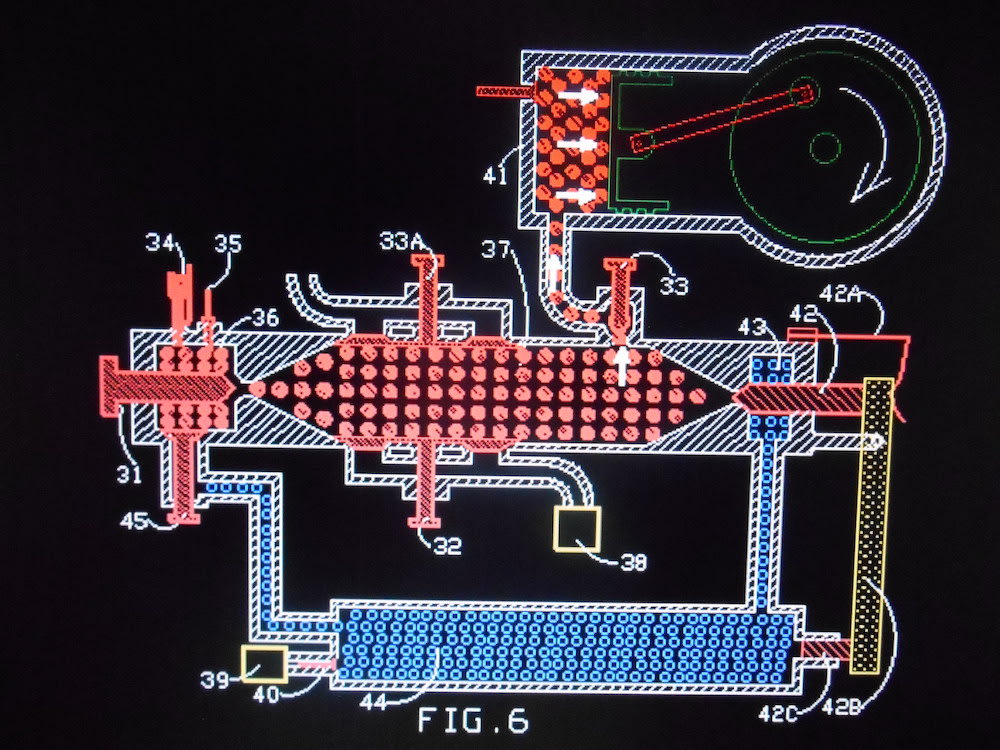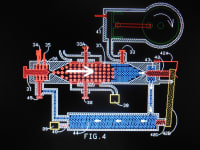See Patent #9,175,641.
This invention is an internal combustion engine which uses "stratified compression" to compress air in an elongated cylinder, the Compression Chamber, without the use of a piston. The invention relies on the phenomenon of an explosion at one end of an long cylinder will compress the air in that cylinder to the opposite end. This compressed air is captured in a separate Compressed Air Chamber via a check valve for use in a future combustion cycle. The relatively high energy gases remaining in the cylinder are then exhausted to a work producing expansion engine such as a piston-cylinder or turbine. The Compressed Air Chamber is connected to a Combustion Chamber via a valve. Fuel is mixed with the compressed air as it enters the Combustion Chamber. There it is ignited via a spark or the heat of compression (as in a diesel cycle). An aerodynamically designed valve and port connect the combustion chamber to the compression chamber.
Referring to the three illustrations submitted:
Fig. 3 shows Combustion Chamber 36 after ignition of the fuel and compressed air. Air at near atmospheric pressure fills Compression Chamber 37.
Fig. 4 shows the phenomenon of stratified compression. Valve 31 opens allowing the high pressure burned gasses to flow into Compression Chamber 37, pushing the air to the opposite end of the Compression Chamber. Lever Arm 42B varies the closing force of Check Valve 42 in proportion to the compressed air pressure.
As an example, in an 18:1 compression ratio design, the compressed air pressure to the right of Check Valve 42 would be approximately 550 psia while the pressure of the burned gasses to the left of Check Valve 42 would be approximately 950 psia.
Fig. 6 shows the opening of Exhaust Valve 33 allowing the high pressure burned gasses to push on a piston in work producing Engine 41.
This invention allows the wall temperatures of the compression chamber to rise far in excess of 400 degrees. This is due to the absence of the oil film required by pistons. This will significantly reduce thermal losses and increase efficiencies.
Due to its simplicity and ability to reach a high number of combustion cycles per minute, it is envisioned that very high power densities are obtainable, hopefully in the order of 1 horsepower per pound. By directly driving a high speed generator with the turbine configuration shown in Figures 15 to 17 of Patent #9,175,641, this becomes an ideal "occasional use" onboard power plant for electric vehicles.
Presently, "range anxiety" greatly reduces the public's demand for electric vehicles. By targeting specific daily mileages of commutes, the vehicle battery's size, cost and charge time can be reduced for specific target markets. Electric vehicles with 30, 40 and 50 mile battery ranges could easily satisfy 10 to 20 percent of daily commuters. This would have an impact on carbon emissions.
Like this entry?
-
About the Entrant
- Name:Marshall Ashmann
- Type of entry:individual
- Software used for this entry:Generic Cadd
- Patent status:patented








